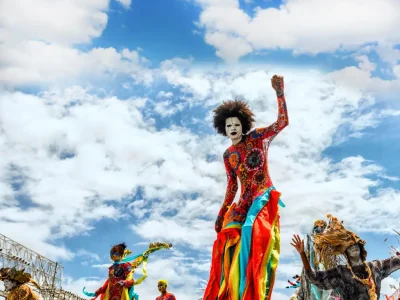In the culturally rich Caribbean islands, people often see fascinating dancers on stilts at carnivals and festivals. These extraordinary figures, called Moko Jumbi or Mocko Jumbie, are captivating stilts, walkers or dancers who have become an integral part of festivals and celebrations throughout the region. But who are these enigmatic characters, and what is the origin of their intriguing name?
Origins and meaning
The term “Moko” originates from Central Africa, where it signifies a healer. “Jumbi” is a Caribbean word for a ghost or spirit, possibly derived from the Kongo language word “zumbi.” Combining these two elements, we arrive at the name Moko Jumbie, which reflects the fusion of African and Caribbean influences within this tradition. The Moko Jumbies are believed to have their roots in West African practices brought to the Caribbean islands through the transatlantic slave trade.
African heritage and Trinidadian adaptations
While the god Moko is associated with the Maasai people from Congo and Nigeria, Trinidad and Tobago have added their own unique touch to this divine figure. In its traditional sense, Moko is a god who watches over his village, possessing the ability to foresee danger and evil because of his towering height. Men on towering stilts would represent Moko, performing awe-inspiring acts that were beyond human comprehension. Some accounts even describe Moko rising from regular height to the skies effortlessly, astounding onlookers.
Trinidad’s adaptation of the Moko figure began during slavery and colonialism when African descendants kept the spirit of Moko alive in their hearts. This spirit eventually found expression in the streets of Trinidad during Carnival, a celebration of freedom and cultural identity. While rooted in African heritage, Trinidad made its imprint on the figure by adding “Jumbie” or ghost to the name. By the early 1900s, Moko Jumbies had become an integral element of Trinidad’s Carnival, assuming the role of protectors of the city and its revellers, warding off evil forces.
However, over time, the prominence of Moko Jumbies in Carnival faded, threatening to consign this captivating tradition to obscurity. In the early 1990s, two individuals, known as Moose and Dragon, emerged as catalysts for a remarkable revival of the Moko Jumbie tradition.
Moose and Dragon, driven by their passion for the Moko Jumbie tradition, embarked on a mission to breathe new life into this fading art form. They sought to bring the Moko Jumbies back to the forefront of carnival, reinventing and reimagining their role in the festivities.
The modern Moko Jumbie
Today, Trinidad boasts two prominent Moko Jumbie bands, Watusi and Kilimanjaro, and several smaller groups. These bands have played a significant role in revitalising and re-establishing the presence of Moko Jumbies in Carnival. The modern Moko Jumbie has become a captivating fusion of African heritage and Trinidadian ingenuity, embodying the spirit of the islands and captivating audiences with their colourful garb, elaborate masks, and towering presence.
Moko Jumbies in the US Virgin Islands
Farther north, on the picturesque island of St. Croix in the US Virgin Islands, the tradition of Moko Jumbies has persisted and flourished as an integral part of local culture. The vibrant spirit of these stilt walkers has not only survived but thrived, with Moko Jumbie teachings being passed down through after-school clubs to young performers. This ensures the preservation and continuation of the traditions associated with Moko Jumbies in the US Virgin Islands.
Other Caribbean islands such as Saint Kitts and Nevis, Jamaica and Barbados have Moko Jumbies at the heart of their carnivals and festivals.
Moko Jumbies in popular culture
The allure and mystique of Moko Jumbies have transcended traditional celebrations and found their way into popular culture. In 2009, the US Department of Tourism of the US Virgin Islands adopted the Moko Jumbie as a symbol for the islands, further cementing their significance.
The Nick Jr. Channel released an animated music video called “Papa Moco Jumbie” in the late 2000s, showcasing the tale of a young boy who aspires to dance like his father, a Moko Jumbie, during the carnival.
The Moko Jumbies, with their towering presence and captivating performances, have become emblematic of the Caribbean spirit and cultural heritage. Rooted in African traditions and adapted by the Caribbean islands, particularly Trinidad and Tobago, these stilt walkers have experienced a remarkable journey of revival and reinvention.





